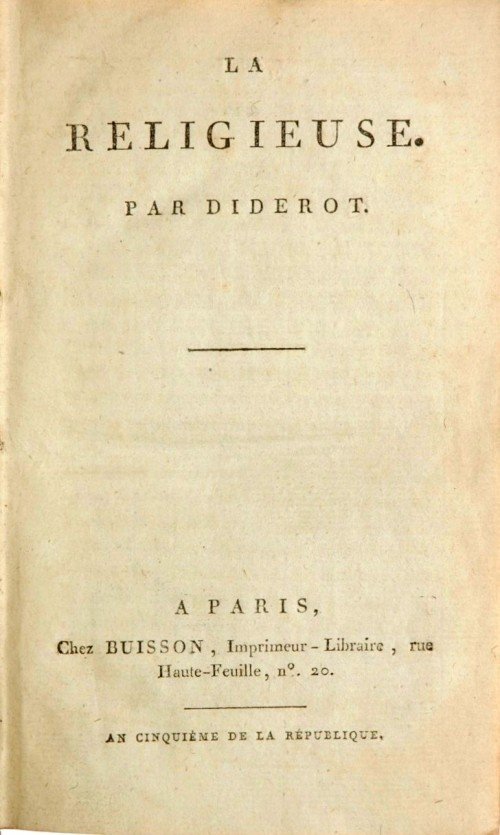Unveiling the Shadows: Exploring Convent Life in 'La Religieuse

Introduction:
In the realm of French literature, few works possess the power to captivate readers quite like "La Religieuse" ("The Nun"). Penned by Denis Diderot, this 18th-century novel delves into the themes of confinement, religious institutions, and personal freedom. Through its compelling narrative and thought-provoking exploration of human nature, "La Religieuse" remains a timeless classic that continues to resonate with readers to this day.
-
A Glimpse into Convent Life: "La Religieuse" offers a chilling portrayal of life within a convent during the 18th century. Diderot skillfully constructs a world governed by strict rules, oppressive authority figures, and the stifling of individuality. The novel introduces us to Suzanne Simonin, a young woman forced into convent life against her will. As readers, we are invited to witness the psychological and emotional turmoil she endures in her quest for liberation.
"La Religieuse" provides readers with a haunting glimpse into the world of convent life during the 18th century. Diderot's portrayal of the convent setting is a deeply introspective exploration of the psychological and emotional toll imposed on its inhabitants.
Within the walls of the convent, Suzanne Simonin, the novel's protagonist, is subjected to a rigid and oppressive environment. The rules and regulations imposed upon the nuns serve to stifle individuality and suppress personal desires. The cloistered existence, marked by a strict routine of prayer, silence, and obedience, is depicted as a form of confinement that denies the basic human need for autonomy and self-expression.
Through Suzanne's eyes, we witness the complex dynamics and power structures at play within the convent. The authority figures, such as the abbess and the prioress, exert control over the nuns, often using their positions to enforce conformity and maintain the status quo. The novel reveals the dark underbelly of religious institutions, where corruption, abuse, and manipulation can thrive behind the façade of piety.
As Suzanne navigates the labyrinthine corridors and observes the interactions among her fellow nuns, we witness the varying degrees of acceptance and resistance to the convent's oppressive environment. Some nuns find solace and fulfillment in their religious devotion, while others, like Suzanne, struggle with their forced confinement and yearn for freedom.
Diderot delves into the psychological effects of confinement on Suzanne's mental state. The novel portrays her internal struggle, as she grapples with feelings of isolation, despair, and a deep longing for liberation. Suzanne's inner turmoil reflects the profound impact of an environment that restricts personal agency and denies the pursuit of individual happiness.
Through its portrayal of convent life, "La Religieuse" sheds light on the broader societal expectations and norms that compelled women to enter religious institutions against their will. It explores the limited options available to women in the 18th century and the complex dynamics of power and control that governed their lives.
In conclusion, "La Religieuse" offers readers a poignant and unsettling glimpse into the world of convent life. Diderot's depiction of the oppressive environment, the power dynamics at play, and the psychological toll on the protagonist serves as a critique of the limitations imposed upon individuals, particularly women, in a society governed by rigid religious and societal norms. Through Suzanne's journey, readers are compelled to question the impact of confinement, the quest for personal autonomy, and the pursuit of individual happiness within the constraints of a restrictive system.
-
The Quest for Autonomy: At its core, "La Religieuse" explores the desire for personal autonomy and the lengths one may go to attain it. Suzanne's relentless pursuit of freedom becomes the driving force behind the narrative. As she navigates the confining walls of the convent, we witness her struggle against societal norms, religious dogma, and the oppressive forces that seek to control her fate. Diderot masterfully portrays the tension between personal agency and external constraints, prompting readers to reflect on the universal human yearning for self-determination.
-
Religious Hypocrisy and Social Critique: Beyond its individualistic themes, "La Religieuse" serves as a vehicle for Diderot's critique of religious institutions and societal norms prevalent in 18th-century France. Through the eyes of Suzanne, the author exposes the hypocrisy, corruption, and abuse of power within the convent walls. Diderot challenges the oppressive practices and blind adherence to religious dogma, provoking readers to question the structures that uphold such injustices.
-
Narration and Narrative Techniques: Diderot employs a unique narrative structure in "La Religieuse" to enhance the impact of the story. The novel consists of a series of fictional letters written by Suzanne to various individuals, including her mother and former lovers. This epistolary style allows for an intimate and confessional tone, granting readers access to Suzanne's innermost thoughts and emotions. Through this technique, Diderot creates a powerful connection between the reader and the protagonist, evoking empathy and a deep understanding of her plight.
-
Legacy and Influence: "La Religieuse" stands as a testament to Diderot's literary prowess and his ability to tackle complex philosophical ideas within a compelling narrative. The novel's controversial nature initially led to its suppression, and it was not published in its complete form until after Diderot's death. However, its impact on subsequent generations of writers and thinkers cannot be overstated. "La Religieuse" serves as a precursor to the French literary tradition of critiquing societal structures and challenging established norms, inspiring later works by authors such as Gustave Flaubert and Simone de Beauvoir.
Conclusion:
Denis Diderot's "La Religieuse" is a work of profound significance that continues to resonate with readers across the centuries. Through its exploration of confinement, personal autonomy, and religious hypocrisy, the novel invites us to reflect on the timeless struggle between individual freedom and societal constraints. As we follow Suzanne Simonin's courageous journey, we are confronted with the profound questions of identity, agency, and the pursuit of truth. "La Religieuse" stands as a testament to the enduring power of literature to provoke introspection and challenge the status quo.